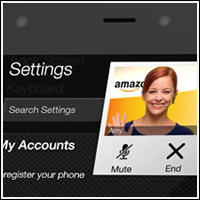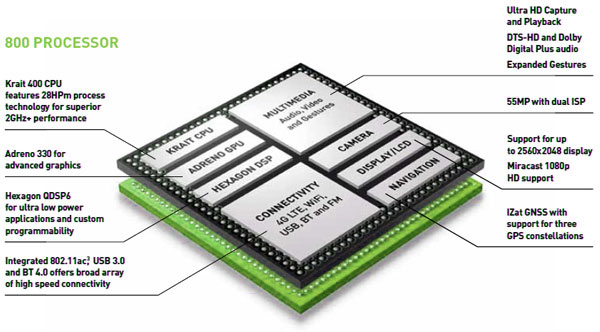
Amazon launched its rather impressive Fire Phone last week, and it has a number of things that make it interesting — but just as the iPhone improved massively by the third version, I expect this phone will as well, as a result of users providing feedback on what they want.
Ironically, if the iPhone fails against the Fire Phone, it will be because Jeff Bezos is executing Steve Jobs’ old strategy of focusing on building a great experience, while Tim Cook shifts Apple to price competition, as a result of his battles with Google and Samsung. I’ll share what I see coming and then close with my product of the week: the Qualcomm 800 processor, which is at the heart of the new Fire Phone.
Modeling Success and Failure
One of the functions of analysts is to document how a leading product will be overcome by a competitor. The analyst starts by assuming the outcome and then works backward to take into account both actual and anticipated events that support that outcome.
The first time I did this was when I co-led the project to spin out the IBM Software Business as a separate company. Detailed analysis indicated with some certainty that if IBM didn’t spin out the business, then Microsoft would pass it by. IBM didn’t, and Microsoft did.
These efforts typically are geared toward preventing the outcome they forecast — not ensuring it — though several times in my career, I’ve failed because I accurately predicted the outcome. In other words, being right isn’t the goal of undertaking this — ensuring you are wrong actually is.
Bezos Mirroring Jobs
What made the iPhone so successful when other screen phones were failing was that Jobs focused more on what the phone did and on the customer experience than he did on the device itself. The phone it was based on, the LG Prada, had been well branded and was just as expensive, but it wasn’t particularly interesting or easy to use. It was very pretty, though.
Screen phones were failing for a number of reasons: They were difficult and unsafe to use (you had to look at them when typing, which increased the difficulty, and if you did this while driving it shortened your life expectancy). They were relatively fragile (it was easy to break a screen), and they got crappy battery life because the screens were so large.
Jobs got people to forget all of that by wrapping the iPhone with apps and iTunes, and making it incredibly easy to use.
Bezos started with a screen phone, then wrapped it with Amazon’s movie and music services, and improved the store-in-your-pocket experience that exists on the Kindle Fire tablets. This shopping experience is one of the Fire Phone’s killer features, and it should appeal to Kindle fire users, much like the Apple fans really embraced the iPhone first.
The lesson folks often forget with a new device like this is to attract your fans first — then move to the rest of the market. Kindle Fire users should love this phone.
The other two killer features are the Mayday button, which is like having an Apple Genius in your pocket, and the 3D display, which creates an “oh wow” sharable experience. Ease of use and the “oh wow” experience connected to the first generation iPhone were what allowed it to quickly dominate the market.
Beating Apple
Amazon won’t beat Apple with the generation-one Fire Phone, and it likely won’t do so with generation two. Generation one is focused on making Kindle Fire tablet users love it, and generation two likely will be focused on fixing any immediate design or use problems. It is typically the generation-three product — assuming one and two have been successful — that steps out and begins to showcase the potential for dominance.
Amazon will beat Apple if Apple continues to go down a path of price-cutting and chasing Samsung rather than leading the market. No one could catch Apple when Apple focused on leading the market, but once Apple started focusing on Samsung, passing it got far easier, and Samsung did it.
However, Samsung isn’t a good leader, and you can see that in its weakening sales numbers. So, if Apple continues to chase Samsung, and Samsung continues to be bad at leading, Amazon wins.
In that scenario, Amazon moves into Apple’s place as market leader, and both Samsung and Apple go after it, but given Amazon operates at break even and has store scale and reach that neither company can match, it is even more unlikely that Amazon can be caught from behind — unless it stumbles — than it was for Apple.
Apple is particularly weak against Amazon’s economic model, which is based on managing to zero. In other words, Amazon can spend every cent it makes in profit and not be killed by investors, because that’s what it currently does.
Apple has huge financial reserves, but it will crush margins if it spends them, and its valuation will fall like a rock, putting the entire executive team at risk. Samsung, which is a low-margin company, was a huge problem for Apple. Amazon is potentially far worse.
Wrapping Up: Count Down to Amazon Leadership
The only way Apple comes out of this on top is if Amazon stumbles like Microsoft did with Zune (which it hasn’t done yet) or if Apple can retake market leadership before Amazon can challenge for it, which isn’t for at least two years, or when the generation-three Fire Phone launches.
Amazon has demonstrated with the Kindle Fire tablet and its core shopping execution that it, unlike Samsung, is fully capable of leading this market, and once it’s out in front, it will be nearly impossible to catch — unless it trips and falls.
In short, Amazon wins if it continues to use Steve Jobs’ playbook with an Amazon spin, and if Apple continues to use a strategy better suited to Samsung or Compaq. Let’s revisit this, assuming we are all still around, in June of 2017.
Product of the Week: Qualcomm Snapdragon 800

Qualcomm’s Snapdragon 800 is an impressive part. In fact, the specs look more appropriate for a PC than a phone, except it isn’t very power hungry. The Qualcomm Snapdragon 800 has four 2.3 GHz cores and a high-performance GPU (for graphics).
It has a world modem that should work anyplace you want to travel and at maximum data rates in most areas (which could actually suck if you get hit with roaming charges).

It supports the new faster USB 3.0 standard if you want to transfer data with a cable (which most of us don’t do anymore), and it will both display and capture 4K video.
One of my personal favorite features is quick-charge 2.0, which helps you charge your device very quickly (I often forget to plug my phone into the charger at night). In short, the Qualcomm Snapdragon 800 carries the Qualcomm banner, showcasing what it can do well, and it is an appropriate choice for a phone that can challenge Apple without breaking the bank.
Because the Qualcomm 800 solution, which isn’t even Qualcomm’s best part (that’s the even more powerful 810), is what makes the Amazon Fire Phone so incredibly versatile, it’s my product of the week.























































The article should more realistically be titled: "How Amazon’s Fire Phone Will Beat the iPhone… When Monkey’s Fly Out of Your Butt" ;-))